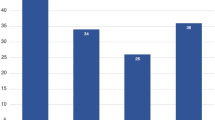Abstract
Study Design
Retrospective chart review.
Objective
Determine if there is a subset of presumed infantile idiopathic scoliosis (IIS) patients who have a low incidence of neural axis abnormalities (NAAs) such that screening magnetic resonance imaging (MRI) may be delayed.
Summary of Background Data
Individuals with presumed IIS have an increased incidence of NAA. Because of the increased incidence, screening MRI is recommended for all patients. We follow these guidelines at our institution. However, MRI screening in this age group is not without cost or risk.
Methods
This is a retrospective study of 53 presumed IIS (onset ≤3 years) patients who had screening MRIs. Demographic and radiographic characteristics were collected. A binary regression using continuous and categorical variables was used to determine if a model could be created to accurately predict MRI necessity. A receiver operating characteristic (ROC) analysis was performed to determine if a threshold Cobb angle exists that is associated with an increased likelihood of NAA.
Results
Of the 53 patients, 13 had NAA findings, resulting in a 24.5% incidence of NAAs. Significantly fewer abnormal MRIs were found in patients with Cobb angles <29.5° than those with Cobb angles >29.5° (13/33 [39%] vs. 0/20 [0%], p = .0008). Patients with Cobb angles >29.5° were 27 times more likely to have NAAs than those with angles <29.5° (odds ratio = 27.0 [95% CI = 1.5–486.0], p = .03). No other parameters have a predictive value for NAA (p > .05).
Conclusion
This is the first study in IIS patients to identify a radiographic parameter that helps select out a subgroup for MRI screening. Additionally, we report an incidence of 24.5% NAAs in these patients, which is higher than previously reported.
Similar content being viewed by others
References
James JI, Lloyd-Roberts GC, Pilcher MF. Infantile structural scoliosis. J Bone Joint Surg Br 1959;41:719–35.
James JI. Idiopathic scoliosis: the prognosis, diagnosis, and operative indications related to curve patterns and the age at onset. J Bone Joint Surg Br 1954;36:36–49.
Pahys JM, Samdani AF, Betz RR. Intraspinal anomalies in infantile idiopathic scoliosis: prevalence and role of magnetic resonance imaging. Spine (Phila Pa 1976) 2009;34:E434–8.
Dobbs MB, Lenke LG, Szymanski DA, et al. Prevalence of neural axis abnormalities in patients with infantile idiopathic scoliosis. J Bone Joint Surg Am 2002;84:2230–4.
Gupta P, Lenke LG, Bridwell KH. Incidence of neural axis abnormalities in infantile and juvenile patients with spinal deformity. Is a magnetic resonance image screening necessary? Spine (Phila Pa 1976) 1998;23:206–10.
Diaz JH, Lockhart CH. Postoperative quadriplegia after spinal fusion with intraoperative awakening. Anesth Analg 1987;66:1039–42.
Noordeen MH, Taylor BA, Edgar MA. Syringomyelia: a potential risk factor in scoliosis surgery. Spine (Phila Pa 1976) 1994;19:1406–9.
Peer S, Krismer M, Judmaier W, et al. The value of MRI in the preoperative assessment of scoliosis. Orthopade 1994;23:318–22.
Ing CH, DiMaggio CJ, Malacova E, et al. Comparative analysis of outcome measures used in examining neurodevelopmental effects of early childhood anesthesia exposure. Anesthesiology 2014;120:1319–32.
Bong CL, Allen JC, Kim JTS. The effects of exposure to general anesthesia in infancy on academic performance at age 12. Anesth Analg 2013;117:1419–28.
Flick RP, Katusic SK, Colligan RC, et al. Cognitive and behavioral outcomes after early exposure to anesthesia and surgery. Pediatrics 2011;128:el053–61.
Zhang H, Du L, Du Z, et al. Association between childhood exposure to single general anesthesia and neurodevelopment: a systematic review and meta-analysis of cohort study. J Anesth 2015;29:749–57.
Qiao J, Zhu Z, Wu T, et al. Indication for preoperative MRI of neural axis abnormalities in patients with presumed thoracolumbar/lumbar idiopathic scoliosis. Eur Spine J 2013;22:360–6.
Rajasekaran S, Kamath V, Kiran R, Prasad Shetty A. Intraspinal anomalies in scoliosis: an MRI analysis of 177 consecutive scoliosis patients. Indian J Orthop 2010;44:57–63.
Schwend RM, Hennrikus W, Hall JE, Emans JB. Childhood scoliosis: clinical indications for magnetic resonance imaging. J Bone Joint Surg Am 1995;77:46–53.
Samuelsson L, Lindell D, Kogler H. Spinal cord and brain stem anomalies in scoliosis. MR screening of 26 cases. Acta Orthop Scand 1991;62:403–6.
Diab M, Landman Z, Lubicky J, et al; Members of the Spinal Deformity Study Group. Use and outcome of MRI in the surgical treatment of adolescent idiopathic scoliosis. Spine (Phila Pa 1976) 2011;36:667–71.
Attenello FJ, McGirt MJ, Atiba A, et al. Suboccipital decompression for Chiari malformation-associated scoliosis: risk factors and time course of deformity progression. J Neurosurg Pediatr 2008;1:456–60.
Bradley LJ, Ratahi ED, Crawford HA, et al. The outcomes of scoliosis surgery in patients with syringomyelia. Spine (Phila Pa 1976) 2007;32:2327–33.
Godzik J, Holekamp TF, Limbrick DD, et al. Risks and outcomes of spinal deformity surgery in Chiari malformation with syringomyelia versus adolescent idiopathic scoliosis. Spine J 2015;15:2002–8.
Kelly MP, Guillaume TJ, Lenke LG. Spinal deformity associated with Chiari malformation. Neurosurg Clin N Am 2015;26:579–85.
Huebert HT, MacKinnon WB. Syringomyelia and scoliosis. J Bone Joint Surg Br 1969;51:338–43.
Ferguson RL, Devine J, Stasikelis P, et al. Outcomes in surgical treatment of “idiopathic-like” scoliosis associated with syringomyelia. J Spinal Disord Tech 2002;15:301–6.
Loder RT, Spiegel D, Guknecht S, et al. The assessment of intraobserver and interobserver error in the measurement of noncongenital scoliosis in children < or = 10 years of age. Spine (Phila Pa 1976) 2004;29:2548–53.
Author information
Authors and Affiliations
Corresponding author
Additional information
Author disclosures: AK (none), JSH (none), NL (none), MO (none), EWH (none), VRT (none), RDM (none), HJI (none).
No funding sources were used for this study.
This study is institutional review board approved.
Rights and permissions
About this article
Cite this article
Kouri, A., Herron, J.S., Lempert, N. et al. Magnetic Resonance Imaging in Infantile Idiopathic Scoliosis: Is Universal Screening Necessary?. Spine Deform 6, 651–655 (2018). https://doi.org/10.1016/j.jspd.2018.04.007
Received:
Revised:
Accepted:
Published:
Issue Date:
DOI: https://doi.org/10.1016/j.jspd.2018.04.007




